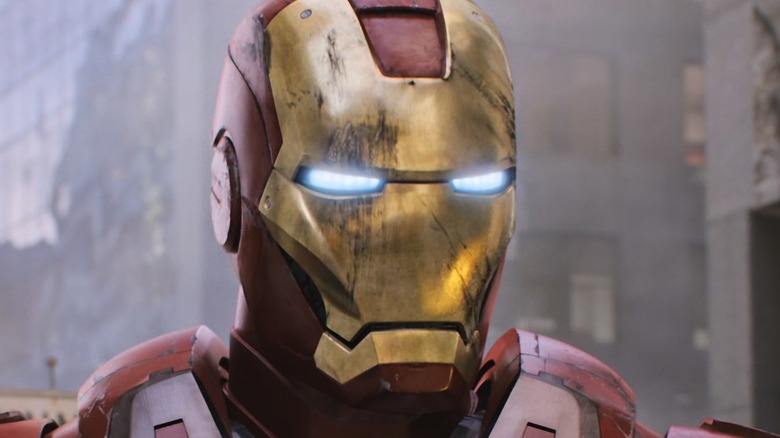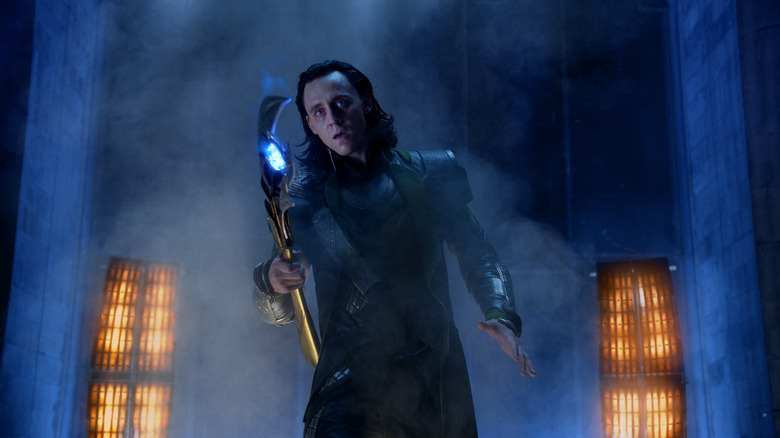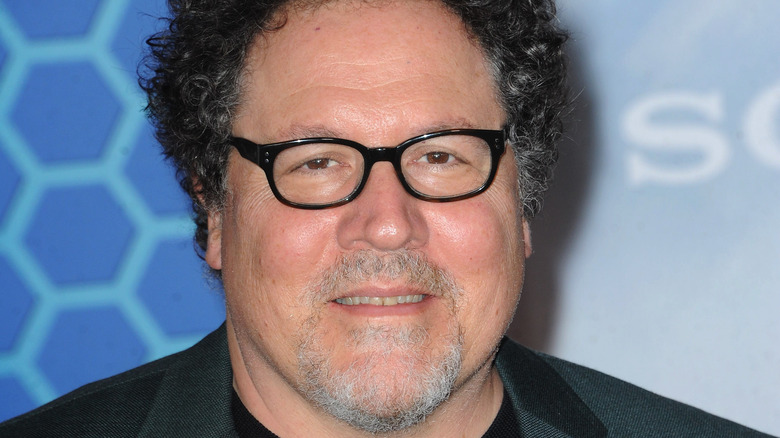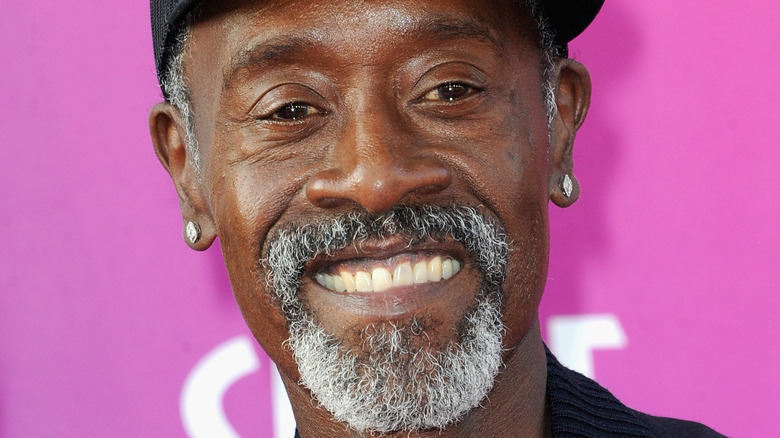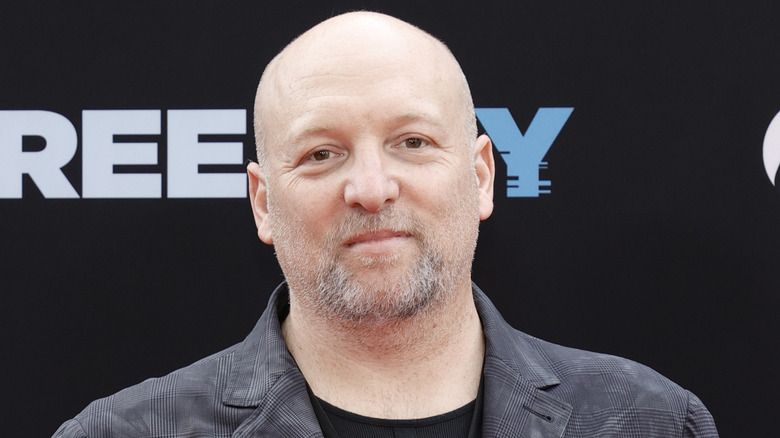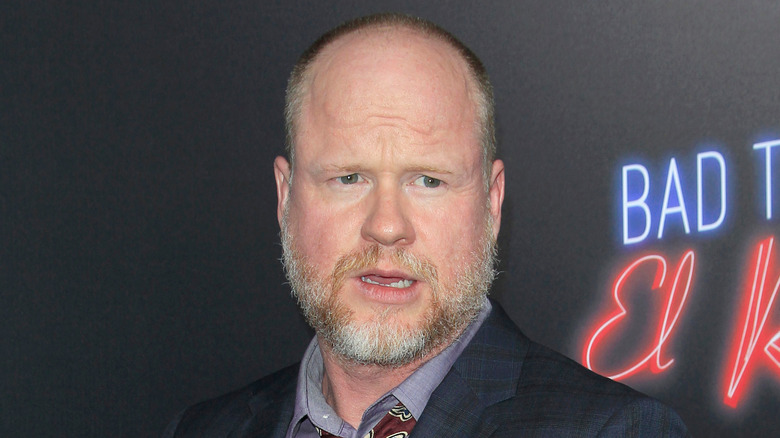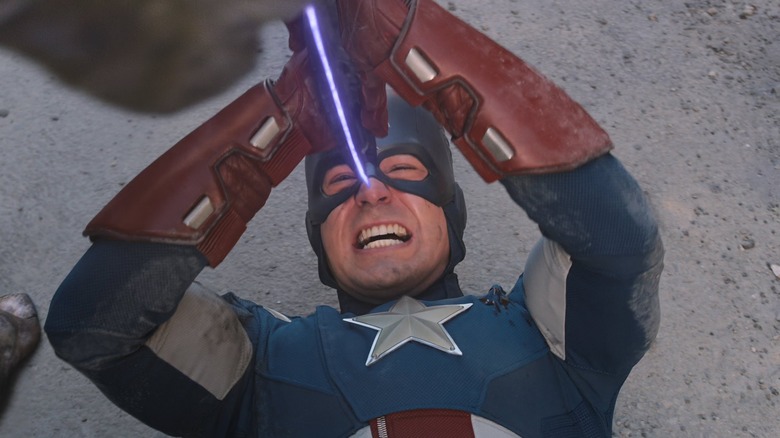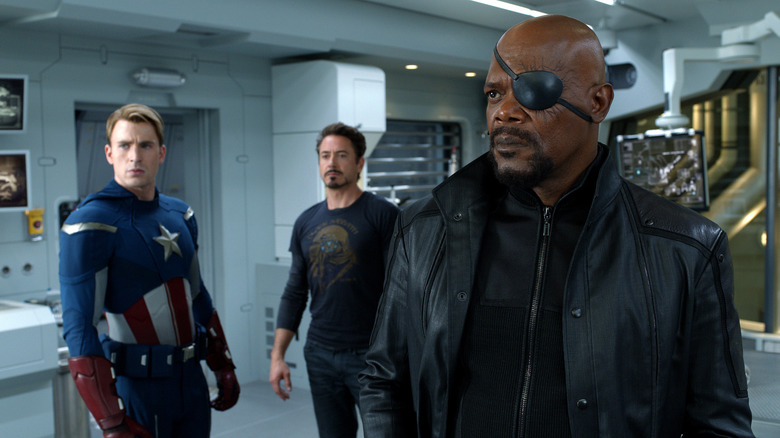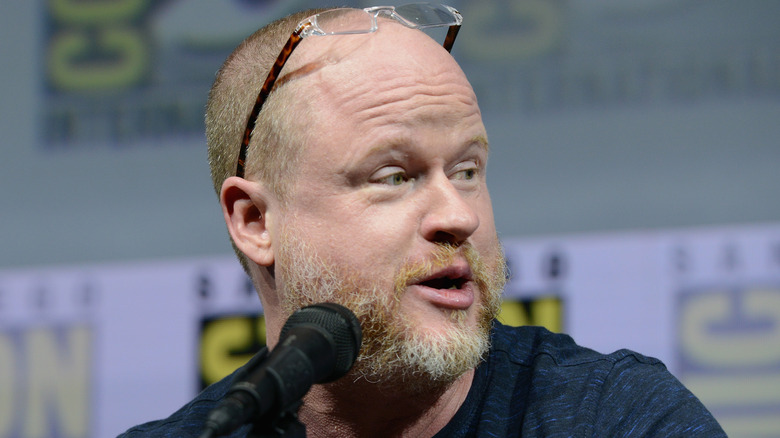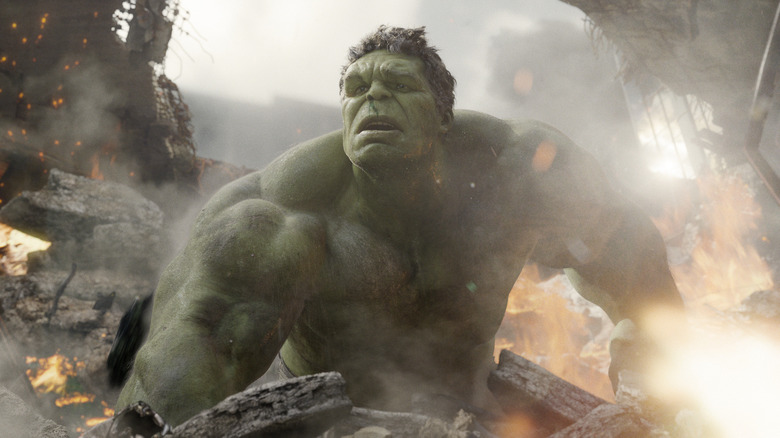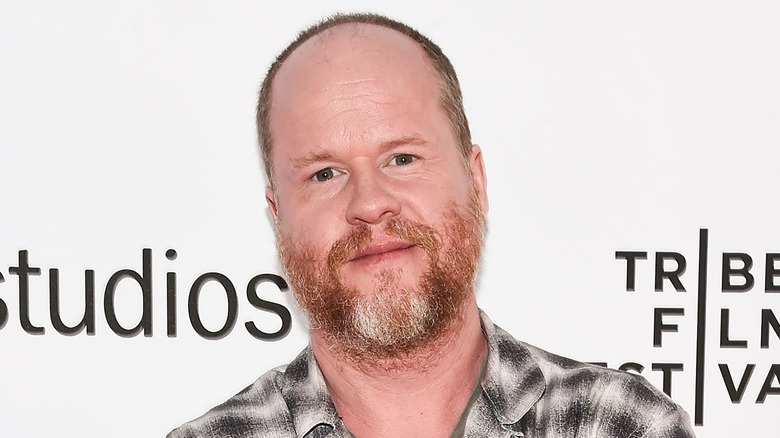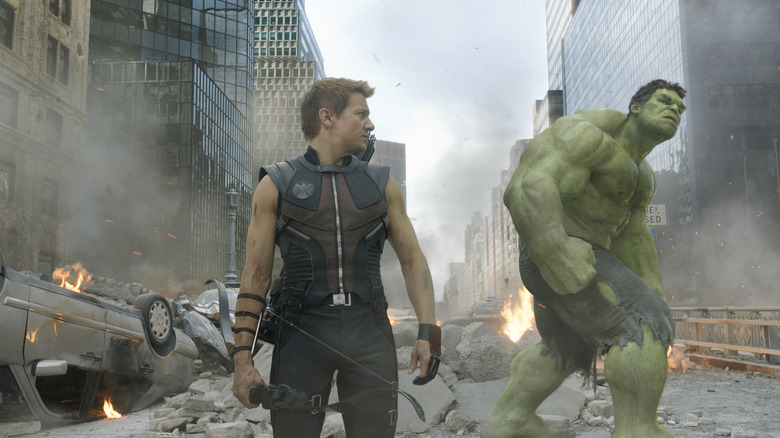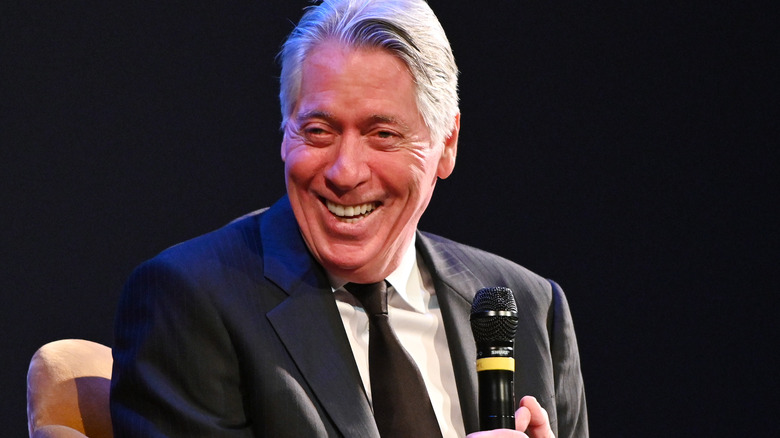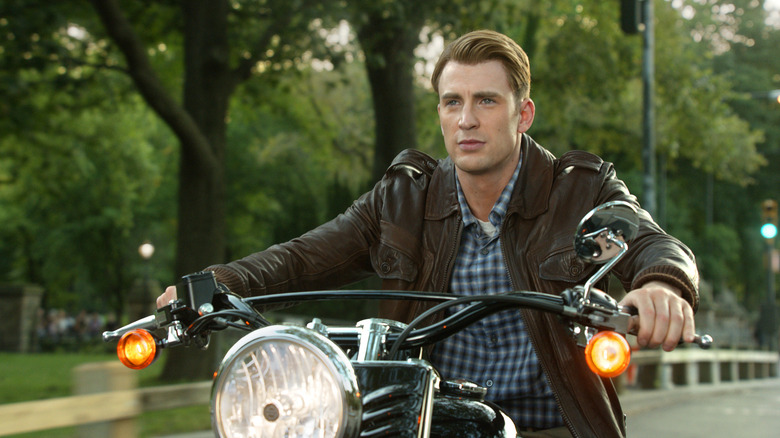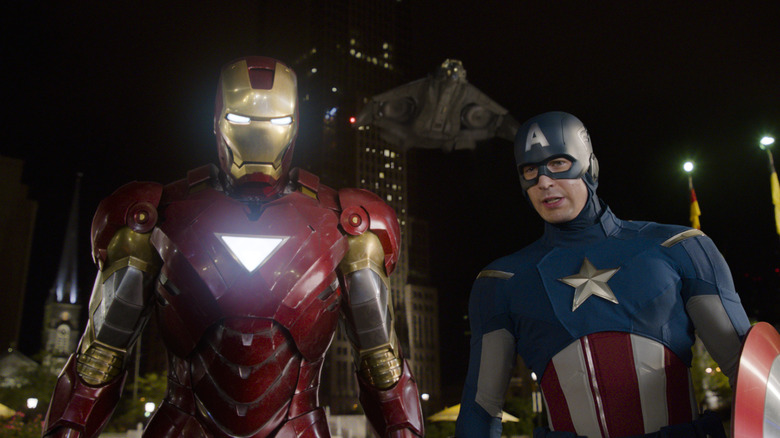The Untold Truth Of The Original Avengers Movie
In May 2012, several new movies were dropping into theaters, including several that featured lots of explosions and the promise of alien invaders destroying Earth. However, only one served as the inaugural live-action film headlined by Earth's Mightiest Heroes. While other May 2012 titles like "Battleship" and "Chernobyl Diaries" are now largely forgotten, "The Avengers" continues to live on and reverberate throughout pop culture. Even with multiple sequels that kept raising the stakes and scope of the action, this initial film still stands out as an impressive feat. The once-ludicrous concept of crossing over multiple superheroes into one movie was proven to have real weight and excitement with the artistic accomplishments of this blockbuster.
Even with the ubiquity of "The Avengers," though, there are lots of aspects around its journey to the silver screen and even its run in movie theaters that are far from common knowledge. These little known elements include Thor's role in one of the earliest drafts of "The Avengers," how much of writer and director Joss Whedon's screenplay was done after the cameras began to roll, and even some of the finer details that brought Mark Ruffalo's the Hulk to life. The untold truth of the original "Avengers" movie speaks volumes to all the work and dedication that went into this beloved blockbuster that continues to have a profound influence on global pop culture.
The original 2011 release date for The Avengers
After "Iron Man" concluded its massive opening weekend, Marvel Studios announced a quartet of big release dates beyond 2008. This was a sign of the company's confidence in itself and an indication that the Marvel Cinematic Universe was not going anywhere soon. The titles that were given far off release dates included an "Iron Man" sequel, the debut solo movies for Thor and Captain America, and, perhaps most enticingly, "The Avengers." First teased in a post-credits sequence on "Iron Man," "The Avengers" was set to close out the summer of 2011 with a bang thanks to its July release date.
The move would allow Marvel Studios to mimic its 2008 slate and have two movies drop in 2010 and 2011, with "Captain America: The First Avenger" set to join "The Avengers" in the latter year with a May 2011 date. However, in March 2009, The Baltimore Sun reported that Marvel Studios had tweaked its release plans and postponed three of its four upcoming movies. While "Iron Man 2" would stay put on track for May 7, 2010, the other three Marvel Studios projects would be getting postponed, with "The Avengers" giving up its July 2011 date to "Captain America: The First Avenger." The first big Marvel Studios team-up movie would now be debuting on May 4, 2012. While arriving later than expected, the eventual positive reviews and box office for "The Avengers" showed that the movie was well worth the wait.
Jon Favreau's concerns for The Avengers
Though nowadays the concept of superheroes from disparate movies coming together sounds like a natural concept, "The Avengers" was once a gravely untested notion that seemed to defy all sensible logic. It wasn't even stockholders or detached media analysts that expressed skepticism over this endeavor. Even those with close ties to the Marvel Cinematic Universe were concerned with how, if at all, this project could be pulled off. This included filmmaker Jon Favreau, who was responsible for helming the first two "Iron Man" titles and kicking off this entire franchise.
In talking to MTV in October 2009, Favreau not only clarified that he wouldn't be directing "The Avengers," he also expressed trepidation over how the character of Iron Man would integrate into the greater MCU. Favreau was very proud of how his two "Iron Man" films existed on a more realistic plane, one that exuded tangibility. When a God of Thunder or a giant green monster entered the picture, would the entire world Favreau had so carefully built for Iron Man come crumbling down?
It was a reasonable concern to have, especially this early in the production when there was no finished script or set director for "The Avengers." Thankfully, both for Favreau and the MCU at large, the final cut of "The Avengers" would delicately bridge the gap between grounded and fantastical superheroes alike.
Don Cheadle was originally set for The Avengers
In the earliest days of pre-production for "The Avengers," Robert Downey Jr. was solidified to be returning as Tony Stark. However, he wasn't the only armored superhero initially set to show up in "The Avengers." Don Cheadle was also initially set to show up as Stark's best friend, James "Rhodey" Rhodes, aka the superhero War Machine. It seemed like a sensible development given how much of "Iron Man 2" was focused on Rhodes taking on the superhero identity of War Machine, though it would end up not coming to pass.
In January 2011, just a few months before "The Avengers" began filming, Cheadle confirmed to MTV that he would not appear in the project as War Machine. He commented that the decision not to have his character appear here made sense, given how he perceived Rhodey as a "lone wolf" who wouldn't join a superhero group. While Rhodey sat out this initial installment of "The Avengers," he wouldn't be absent from future superhero movie crossovers in the Marvel Cinematic Universe. The actor would portray War Machine in all three "Avengers" sequels while also further reprising the character in other projects ranging from "Captain America: Civil War" to the miniseries "The Falcon and the Winter Soldier."
Writer Zak Penn didn't originally want to use Thor too much
If there was a member of the titular superhero group in "The Avengers" that seemed problematic, it was Thor. Before May 2011, when the original "Thor" film opened, he was a loose cannon. He wasn't the centerpiece of a successful solo film series like Iron Man nor an icon of the comics like the Hulk or Captain America. Thor was a god, one who could have the potential to be too powerful for the audience to relate to or suck all the tension out of any dramatic scenario. Even original "The Avengers" screenwriter Zak Penn shared this general trepidation over whether or not Thor could work in this team-up effort.
Penn's hesitancy over this character being able to function in a group setting went so deep that he initially sidelined Thor for long stretches of "The Avengers." However, in reminiscing about his time on this film to The Hollywood Reporter, Penn recalled how it wasn't long before he changed his tune. Getting to see the first "Thor" movie come together, along with an early encounter with Chris Hemsworth right after he got cast as Thor, immediately changed his mind. Rather than seeing Thor as an impenetrable character that audiences could never get behind, Penn saw all the possibilities that this cosmic superhero had. From there, Penn stopped holding back on Thor and the character would eventually become a key part of the final cut of "The Avengers."
Joss Whedon's initial plan to use The Wasp
The earliest days of working on "The Avengers" were full of trial and error, even on basic things like which superheroes would headline the production. The project was so nebulously defined at the start that Joss Whedon initially planned to bring in one of the original founding members of the team from the comics, Janet Van Dyne, aka the Wasp. In "The Art of Marvel Studios," per SlashFilm, producer Jeremy Latcham noted that she was one of the most prominent characters in an early draft of "The Avengers" — Whedon even had Zooey Deschanel in mind to portray the superhero.
The Wasp's presence in the film solely came down to the fact that, apparently, there was a moment in the development of "The Avengers" where it appeared Scarlett Johansson would not be able to appear in the movie. With Black Widow potentially out, "The Avenger" needed another female superhero to appear in a prominent position. This is where the Wasp came in, with the character eventually becoming so prominent in the screenplay that she was equivalent to being the lead character. Once Johansson's schedule cleared up, and she could do "The Avengers" again, Whedon had to rewrite his screenplay and remove the Wasp. Fans of the character would have to wait until the "Ant-Man" movies for this superhero to make her big-screen debut instead.
Why Paramount got its logo on The Avengers
Among its other historical qualities, "The Avengers" was a milestone title for Disney. After the company purchased Marvel Entertainment in 2009, the Mouse House hoped to suddenly get a new stream of box office hits thanks to its ability to release major superhero tentpoles. Initially, the theatrical distribution deal between Marvel Studios and Paramount Pictures appeared to disrupt these plans, as the two companies had a deal stretching through "Iron Man 3" in May 2013. However, in October 2010, Disney struck a deal to secure the distribution rights to "The Avengers" and "Iron Man 3," ensuring it's the company's first big superhero blockbusters.
However, once the marketing began for "The Avengers," eagle-eyed viewers noticed that the film's trailer began with a Paramount Pictures logo. What was going on here? Variety clarified things in October 2011 by noting that part of the distribution agreement between Disney and Paramount was that the latter studio got to keep its logo on both "The Avengers" and "Iron Man 3." This extended to not just the trailers and posters but the films themselves. This went hand-in-hand with Paramount maintaining pay-TV rights to the two movies and getting eight to nine percent of their worldwide box office.
Though the end credits for both features prominently note that these titles were distributed theatrically by Disney, Paramount Pictures was still able to secure one last prominent boost in publicity from its connections with Marvel Studios.
The Avengers script was being written when principal photography was happening
Conventional wisdom suggests that a movie that costs a lot to make would have everything planned out right down to the letter before the cameras begin to roll. However, in mainstream Hollywood, where release dates take precedent above all else, that doesn't tend to be the case. Big-budget endeavors like "Jurassic Park 3" infamously kicked off principal photography without a completed screenplay and were flying by the seat of their pants. Though not the most extreme version of this phenomenon, "The Avengers" was another example of this trend, as the screenplay was still being polished once shooting was underway.
While talking to Film Festival Traveler, Joss Whedon divulged how there were "a few key scenes" that still needed to be written once "The Avengers" began filming. He did note that these scenes were the exception rather than the rule to the rest of the screenplay, which was mostly set in stone once the cameras began to roll. But for certain unspecified sequences, Whedon was tweaking the dialogue and actions right up until these moments were being performed. It can be stunning to realize how these costly blockbusters can be made in such a freewheeling manner, though the positive reviews for "The Avengers" suggest that this approach didn't hurt the movie's overall quality.
Joss Whedon's approach to digital 3D
"The Avengers" went into production in the heyday of digital 3D. Thanks to "Avatar" breaking the bank at the box office, every big-budget action movie was now looking to utilize this technology and get some of that box office glory. Marvel Studios was no exception, with the company releasing its titles in digital 3D starting with 2011's "Thor." "The Avengers" would be the third Marvel Cinematic Universe installment to be projected in this cutting-edge format, and director Joss Whedon had some very specific thoughts on how it should be implemented into the story.
Talking to JoBlo, Whedon revealed that digital 3D projection was constantly on the forefront of his mind during principal photography of "The Avengers." Despite it being something he was frequently aware of, though, Whedon was determined to make sure the story didn't bend to the whims of what would look good in digital 3D. Instead, he wanted to implement the technology organically, with Whedon feeling that action movies naturally lend themselves to the format. He also noted that his affinity as a filmmaker for being cognizant of the space his characters occupied meant that digital 3D aligned nicely with his priorities as a filmmaker. Thanks to these qualities and thoughts, "The Avengers" delivered a digital 3D experience that didn't just register as a way of chasing the lightning in a bottle success of "Avatar."
The visual effects design decisions behind the Hulk
"The Avengers" was the third live-action blockbuster movie to feature Bruce Banner, aka the Hulk, which meant audiences were already plenty accustomed to the sight of a CG version of this big green superhero smashing his way across the silver screen. However, "The Avengers" version of Hulk would be a different beast compared to its predecessor in terms of the visual effects used to render this incarnation of the character. A crack team of artists was hard at work getting this take on the Hulk to be as sharp as it could possibly be.
Industrial Light & Magic visual effects supervisor Jeff White told Animation World Network that a critical difference in how the new version of the Hulk was realized lay in the idea to make Mark Ruffalo's features visible. Once they worked in the tiniest details from this actor onto the Hulk, they could create an unprecedented sense of visual unity between the two parts of Bruce Banner. There was also the conscious decision to tone down the character's green hue so that he didn't stand out quite so much next to his cohorts. Though these may seem like simple decisions on paper, they were critical to making sure that this version of the Hulk resonated as no other had before with general moviegoers.
Joss Whedon wasn't super beholden to the comics
The various Marvel Cinematic Universe titles have certainly done their best to respect and translate many beloved aspects of these assorted superheroes from their comic book origins. However, no comic book movie is completely faithful to its source material, as the very nature of adaptations means that some things have to get altered when translated to the big screen. For "The Avengers," Joss Whedon had decades worth of material to lean on when it came to bringing this superhero team to life. Rather than straining to appease every era of the Avengers in the comics, Whedon decided to focus on making a good film.
"The truly iconic stuff from the comics isn't really in the film," Whedon explained to Collider. Though he noted that different aspects of various incarnations of the Avengers team from the comics would find its way into the final cut, they weren't seeking out specific storylines to directly adapt nor were they constrained by the past. For Whedon, his approach to bringing this material to the world of live-action filmmaking was "to take all of those [iconic moments] and distill them the same way the costumers do and everybody... Distill them and then find your own. I mean ultimately for me the most iconic moment in the movie is, assuming they do, when they assemble." With that intact, the director could march on with this ambitious crossover without worrying about betraying the source material.
Joss Whedon eschewed setting up future movies in The Avengers
The Phase One MCU movies are chock full of teases for upcoming installments in the franchise ran rampant. Hawkeye appeared in a lengthy cameo in "Thor," for instance, while much of the runtime of "Iron Man 2" was dedicated to laying the groundwork for "The Avengers." Given these prominent examples, it would have been understandable for general moviegoers to expect that "The Avengers" would be continuing this trend.
However, in talking to Collider, Joss Whedon revealed that he didn't get any pressure from Marvel Studios to provide set-up for future movies, nor did he add any such details of his own accord. While he saw the film as having several plot elements that could be further explored in later MCU titles, Whedon primarily concentrated on getting this one movie off the ground. In trying to make sure Thor and Iron Man could properly interact, he didn't have time to also drop overt teases for "Iron Man 3" and "Thor: The Dark World." While a departure from other Phase One Marvel Studios projects, this approach would end up informing the self-contained nature of "The Avengers" that so many viewers found irresistible.
Alan Silvestri's experience composing the score for The Avengers
Composer Alan Silvestri entered the Marvel Cinematic Universe with his work on "Captain America: The First Avenger" and would return to the franchise with the very next installment in the franchise, "The Avengers." In an interview with AssignmentX, Silvestri divulged that he felt his work on that earlier Marvel Studios project was instrumental in him getting the opportunity to score "The Avengers." With Marvel Studios and Joss Whedon wanting to make sure "The Avengers" was directly connected to the other MCU features, it only made sense to bring a composer familiar with this world.
Even with the inaugural "Captain America" movie under his belt, though, Silvestri was not entering "The Avengers" totally free of stress. In fact, he entered this production conscious of all the build-up to this crossover. However, with so much to accomplish in getting these compositions finished, Silvestri managed to put his nerves on the backburner and focus on crafting some memorable music for a memorable superhero blockbuster. Among those efforts included fulfilling a mandate to make a piece of instantly recognizable theme music for the titular superhero group and making sure that his orchestral tunes didn't get lost in the grand sweep of the climactic Battle of New York.
There was a lot to juggle in delivering a quality score for "The Avengers," but an old pro like Alan Silvestri managed to navigate all those quandaries with flair.
Why did The Avengers get a different title in the United Kingdom?
If you saw "The Avengers" in movie theaters in the United Kingdom, you might have noticed that the film was marketed with a different title in this country. Exclusively in the United Kingdom, the sixth installment in the MCU was titled "Avengers Assemble." The distinctly different moniker was due to the popularity of the 1960s spy show "The Avengers" in the region. Opting not to confuse moviegoers who would think there was some connection between the two properties, Disney and Marvel Studios opted to give "The Avengers" a new title.
David Vox of The Guardian penned a piece on the title just before "The Avengers" hit British movie theaters and commented that the redubbed title had earned controversy from United Kingdom moviegoers. Cox also observed that "The Avengers" was given a new title very hastily in the United Kingdom, with the "Avengers Assemble" moniker only emerging in February 2012, mere weeks before its late April 2012 debut in theaters in this territory. The whole situation was a bizarre one, though, thankfully for British moviegoers, all "The Avengers" sequels did not have to carry the clunky "Avengers Assemble" name. This boon for titles like "Avengers: Endgame," though, only makes the presence of this title on the original "Avengers" all the more confounding.
The Avengers and its box office records
It's important to remember that, before "The Avengers," the largest Marvel Cinematic Universe worldwide was the $621 million haul of "Iron Man 2." Of the first five entries in this saga, only two managed to exceed $460 million globally. The MCU had been successful but had never shattered all box office records like "The Avengers" would end up doing. The financial strength of this project was apparent by the end of its North American opening weekend. Over three days, "The Avengers" amassed $207.4 million in that territory, per The Hollywood Reporter. Not only was that the biggest domestic bow ever, but this was also the first time in history that a movie exceeded $200 million in three days in this country.
"The Avengers" wasn't one of those box office performers that plummeted after its opening weekend, though. It held well enough in its second North American weekend to become the first title to gross over $100 million in its second frame of domestic release, according to Box Office Mojo. Its incredible financial success also occurred in international territories, with The Hollywood Reporter revealing that "The Avengers" proved lucrative enough overseas to score $1.3 billion worldwide by early June 2012. At this point, it became the third-biggest movie ever globally at the time and the biggest film ever globally that wasn't directed by James Cameron. Its eventual $1.5 billion worldwide haul was more than twice times the global gross of "Iron Man 2" from just two years earlier, a testament to the box office prowess of "The Avengers."
